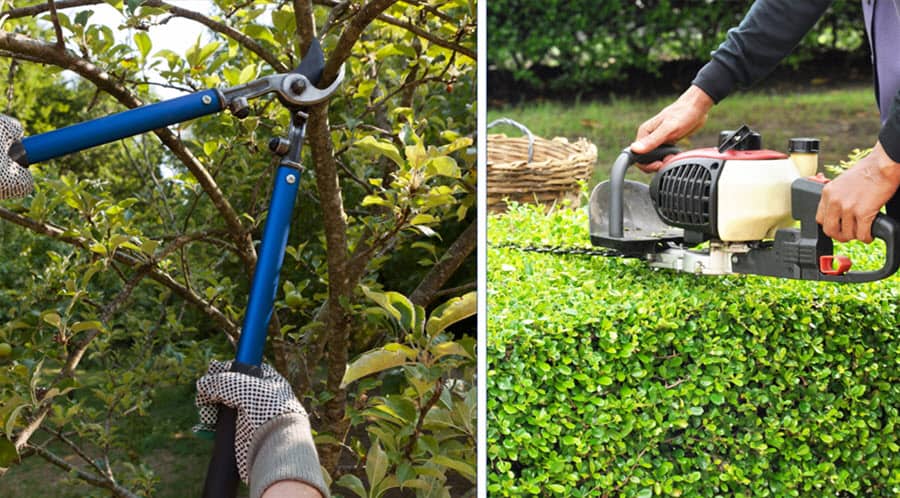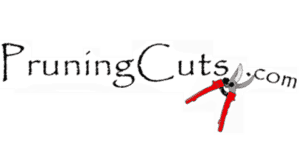
When my friends and neighbors ask me about trimming their shrubs or pruning their plants, I have to take a moment to find out exactly what they want to do. That’s because most people use the terms pruning and trimming interchangeably. Oh, and just to be clear, this is not me being pedantic. You could run into some very real problems by using the wrong term.
Is Pruning The Same As Trimming? Pruning and trimming are different. When pruning you make precise cuts, one stem at a time, by hand, to promote the health and/or growth of a plant. Trimming, you clip multiple stems at once in order to maintain the plants’ shape because less precision is required.
Many people inadvertantly end up trimming when they should really be pruning. Not only that but they can also end up using the wrong tools and incorrect techniques which can result in severe damage or even the death of a plant. So let’s get down to details about the differences and ensure you make the best, informed choices for your garden.
Is Pruning The Same As Trimming?
Pruning is not the same as trimming. The two are similar because they both involve cutting a stem, limb, or branch of a plant, but that is where the similarity pretty much ends. They are different in:
- The reasons why you would carry them out
- The results you can expect when you carry out trimming vs. pruning
- The techniques used in trimming and pruning to ensure the health and wellbeing of the plants.
- The equipment you should be using to
sucessfully prune vs. the tools you need for trimming.
If you are planning to cut any of the plants in your garden, it is important to know the differences between pruning and trimming, especially if you are going to ask for advice when purchasing equipment or materials.
Ask an associate in your local garden center to recommend the best tool for trimming your shrubs and they are likely to show you their best hedge trimmers. These may be just what you need if you are indeed trimming a shrub.
However
What if you are actually planning to cut back some of the shrubs in order to remove an area of diseased stems or to encourage a thicker, healthier crown? If you ask for the best trimming tool in this case because you think pruning and trimming are the same, then you are going to end up with a tool which is entirely unsuitable for your needs.
And Not Just That
A similar situation can arise if you are thinking of paying for a professional to do some work in your garden. Book someone to come and prune your trees when, in fact, what you actually need is tree trimming and you ritsk having someone turn up, ill-prepared for the job at hand.
To help you avoid buying a trimmer when what you want is a pruner or hiring a gardener to prune your trees when what you actually want is an arborist to trim them, here is a complete rundown of all the ways in which pruning and trimming are different.
NOTE: To avoid writing plants and shrubs, and trees in every sentence, Therefore I am generally going to use the words shrub or shrubs most often in the rest of this article, but the same information applies to trees and other plants in exactly the same way, even if they are not explicitly mentioned.
What Are The Reasons Why You Want To Cut Back Your Shrubs/Trees?
Pruning
Pruning is usually carried out for one of these four reasons:
- To remove a sick, damaged or diseased part of the shrub
- In order to eliminate a dead or dying area of the plant and stimulate new growth
- Cutting back either a small part of or an entire area of, a shrub to achieve a specific growth goal. This could be to keep the shrub shorter or more narrow than it would naturally grow, to train the shrub to a particular shape, or to encourage more prolific flower or fruit production.
- Maintaining the general good health of your shrub
Trimming
Generally, the reason for trimming a shrub is to maintain the size and shape of the plant, usually after a more formal shape has been created. Trimming is usually carried out after pruning has been used to achieve the desired appearance.
Pruning / Trimming Results
Closely related to the objectives of cutting your shrubs are the results you wish to achieve.
Pruning
For example, using our four main reasons for pruning your desired results may be to:
- Prevent the spread of disease both throughout the affected shrub and to other plants in your yard. For this, you may have to remove s small, single stem, or multiple stems in order to arrest the spread of disease.
- Encourage new growth. An example would be in the case of a shrub that is dead in the center but has plenty of healthy growth around the outside. You would use pruning techniques to thin out the dead foliage or stems, usually removing a third at a time to avoid damage to the plant. This would allow light and air to reach the inner section of the shrub and by using other pruning techniques to encourage new stems, you would be able to stimulate new growth.
- Stimulate a specific form of growth. For example, heading back, a branch and removing the “leader” will produce side shoots and make the foliage of the shrub denser. Likewise removing stems with flowering buds will divert more of the plants’ energy into the remaining buds which in turn, results in fewer but bigger flowers.
- Ensure the optimal kind of growth to have your shrub continue to produce fruit. For example in the case of blackberries on which the fruit grows best on two-year-old stems. Therefore you prune back older growth to stimulate new stems at the base which will, in turn, will extend the fruit-bearing life of your plant.
- Have your shrub conform to a specific form. For instance, you may wish to train a fruit tree as an espalier. This is the type of tree that you see pruned so that it grows against a supporting structure with the limbs spread out
againt a wall.
Trimming
The range of results achieved by proper trimming is much more narrow. The only thing you should plan to achieve from trimming is the maintenance of a shrubs appearance. The only exception to this is on an occasion where you may want to make a change to the
The obvious example is the trimming of a hedge. After you have obtained your desired, usually formal or geometric size and shape, you would maintain the shape with regular trimming.
On occasion you may wish to make minor changes to the general appearance of the hedge, in which case trimming might be appropriate.
Comparing Techniques
The techniques used in pruning and trimming also differ from each other. The main distinction is that pruning cuts are:
- Only made to one stem at a time.
- Carried out with precision to ensure the cut does not damage your plant.
- Carefully planned so you end up with the required end result.
You should think of pruning as the “mico,” detailed cutting of a plant.
Meanwhile trimming is more of a “macro” form of cutting a shrub. Although you must still take care and plan how, where, and when to cut, with trimming multiple stems are cut at once.
Pruning Technique
There are two main types of cuts when you are pruning; thinning cuts and heading cuts.
You use heading cuts to stimulate growth. The bud which remains below the cut
So, if you want a shrub to grow, for example, towards your house, you must make a cut just above a bud which is already facing your home. You should not attempt to cut above a bud on the opposite side of the stem and then force the growing branch to loop around and face the house.
Thinning cuts are used to remove branches or stems without stimulating additional growth. They are made at the point where the stem or branch meets the rest of the shrub.
So, for example, you may have a shrub that has grown under a window and if it continues to grow naturally it will begin to block the light. You do not want to prune in such a way that is likely to stimulate further growth so you would remove a select branch or two and cut them at the base of the stem, where it emerges from the rest of the plant.
Trimming
Trimming techniques can vary according to the specific species of plant and the form in which the shrub has been trained. So, for example, to cut a formal box hedge you would begin by marking out the shape at the bottom of your hedge using small wooden stakes. Then tie a string to the stakes to outline your desired height and width being careful to make sure the top of your hedge is not wider than the bottom.
Using the string as a guide you would then gently run your hedge trimmer over the outer layer, never sinking the trimmer deeply enough fo it to be lost from sight. Cuts are made with a gentle, light, sweeping motion, from the bottom of the plant upward. If you sweep the trimmer from top to bottom you risk cutting into and tearing the branches.
Equipment
As you might expect, pruning requires small, sharp tools which can be easily manipulated in order to make precise cuts. To prune you can use your fingers, such as when you carry out pinching in a smaller plant.
As the thickness of the stems you plan to prune increases, you use a pruner, lopper, or pruning saw depending on the stem size.. Each of these tools gives you the ability to cut-back one stem at a time and make exact cuts.
For trimming you use either a larger pair of hand shears or a power trimming which allows you to cut multiple stems at once.
Do not make the mistake of mixing “pruning shears” with hedge shears. The style of shears designed for trimming has much longer blades so you can cut multiple stems at once and require two hands to use. On the other hand pruning shears are a single hand tool with short blades which only allow you to cut one stem at a time.
Conclusion
Pruning is the technique you use to make cuts to one stem at a time, with the intention of combating disease, controlling growth, and stimulating the production of fruits or flowers.
Pruning cuts are small, carefully placed, and precise.
With trimming you cut multiple items at one time and although it to should be well planed and precise it is used for the maintenance of form, size, and appearance.
